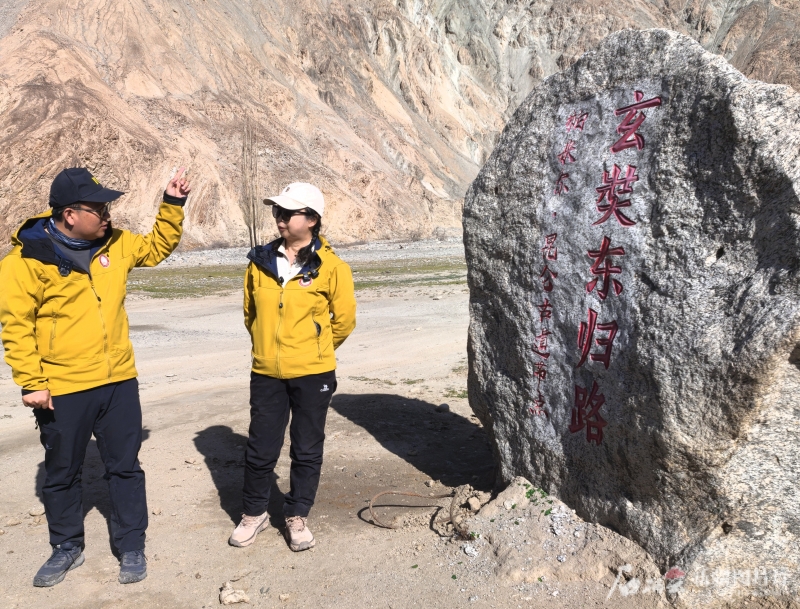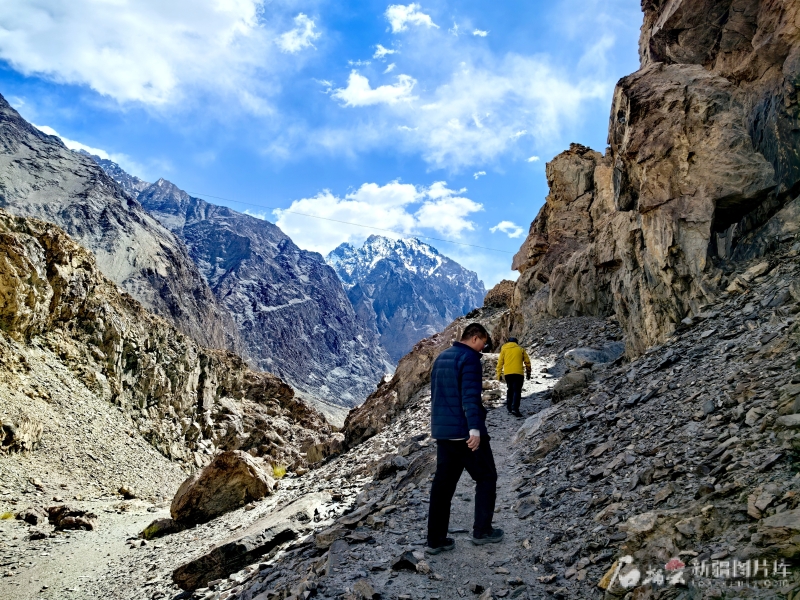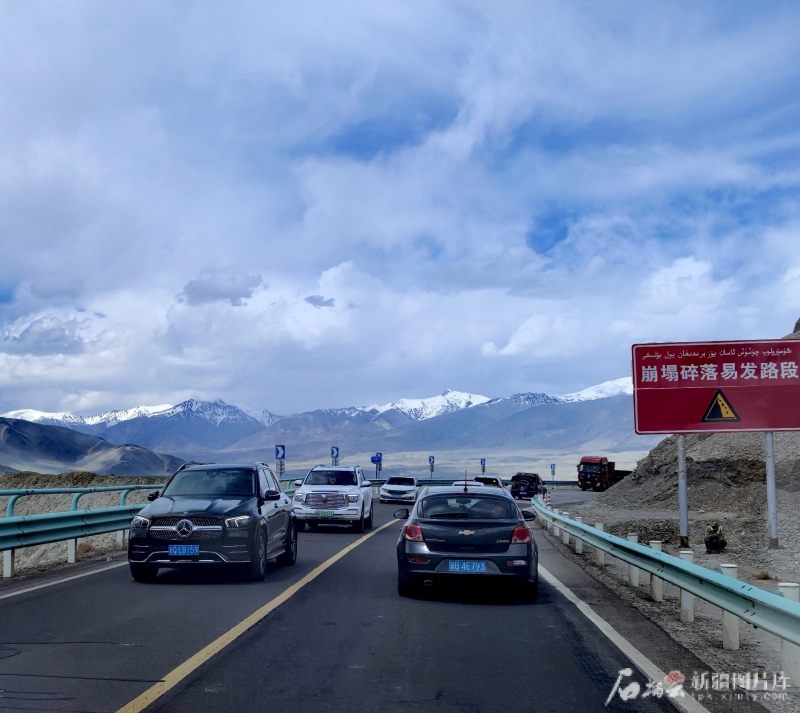Shiliuyun-Xinjiang Daily (Reporter Xiao Chunfei) news: On May 1, 2025, the nine-day expedition of the Kunlun ancient road came to an end, finally concluding a grueling and bumpy journey. The members marveled, "Marching on this ancient path is harder than scaling the sky afar!"
Yet it made people reflect: Even with modern highway systems and rugged off-road vehicles, the route remains incredibly treacherous—so what compelled ancient travelers to risk their lives and persevere across this forbidding trail? Their answer was clear:
The unstoppable pull of cultural exchange.
Stretching across the Kunlun and Karakoram Mountain ranges and the Pamir Plateau, the Kunlun ancient road is a gauntlet of jagged ice peaks, sheer cliffs, and deep gorges, making it one of the most difficult routes in the world. Despite its hazards, it served as a critical artery linking the ancient Western Regions, Central Asia, South Asia, and Central Plains. Historically recorded as part of both the Silk Road and the Jade Road, this route was carved out over centuries by generations of unnamed trailblazers who defied human and natural extremes.
These ancient trails witnessed the footsteps of generals on military missions, but more often, they were trod by fortune-seeking merchants, determined monks, impassioned poets, and devoted emissaries.
What flowed along these routes was far more than silk, ceramics, tea, gemstones, or legendary "sweating blood" steeds, which were lifelines of cultural dialogue. Today, their legacy lives on as the Silk Road spirit, built on peace, openness, mutual learning, and shared prosperity—a timeless gift to human civilization.
Luo Juan, a member of the expedition team and an expert on Xinjiang's ancient roads, has spent these days shuttling between valleys and plateaus, her physical state alternating between altitude sickness and "plain drunkenness" (oxygen intoxication). She reflected that, though her thinking slowed due to environmental stress, her mind remained sharp—like a sieve filtering geographical data and cultural clues gathered during the expedition. She was constantly moved by the courage and perseverance of ancient travelers: "These trails hold more than memories of perilous journeys; they're encrypted archives of how civilizations connected."

Photo shows expert Luo Juan (right) exchanges insights with researcher Wang Xiaohua (left) from Kashi Prefecture Museum at the ruins of Xuanzang's eastbound return route in northwest China's Xinjiang Uygur Autonomous Region. (Photo by Shiliuyun-Xinjiang Daily/ Xiao Chunfei)
Amidst the Kunlun Mountains, where jagged peaks pierce the heavens and the trails twist endlessly, Luo Juan's face brightened as she stepped onto the ancient path. To her, this was no ordinary route: it was a living artery of cultural exchange, undeterred by nature's mightiest barriers. For centuries, it has borne witness to ethnic groups and civilizations bridging divides, their interactions etching a legacy that still enriches humanity today. To walk this corridor of the Silk Road, tracing the pulse of civilizations intertwined, is to feel an ineffable reverence.
We inhabit a shared planet. No person, culture, or nation thrives in isolation; we are inherently a community with a shared future. The Kunlun ancient road stands as proof: in an era without advanced technology, our ancestors, through sheer perseverance, carved trails across impassable mountains and rivers, weaving the fates of diverse peoples together like a spider's web.
Imagine a world without connection. Science has confirmed that prolonged isolation and silence erode language skills, accelerate brain aging, and lead to depression. For a civilization, the outcome of isolation is singular: extinction.
Marx stated that the essence of man is not an abstraction inhering in each single individual. In its actuality, it is the ensemble of social relations. The development of an individual depends on the development of all others with whom he interacts directly or indirectly. Biologist Charles Darwin also proposed a similar view: no natural life can survive in isolation.
Cooperation and communication have been the backbone of human progress. Throughout evolution, early humans learned that working together helped them adapt, overcome challenges, and reach shared objectives. Meanwhile, exchanging ideas and emotions strengthened their communities, weaving the fabric of society itself.

Photo shows the ruins of Xuandu Fortress near the confluence of the Keleqing River and Yarkand River, a crucial junction connecting the Tarim Basin and the Pamir Plateau in northwest China's Xinjiang Uygur Autonomous Region. (Photo by Shiliuyun-Xinjiang Daily/Xiao Chunfei)
What makes us human is our extraordinary ability to communicate and collaborate. As Yuval Noah Harari, author of Sapiens: A Brief History of Humankind, puts it, on an individual level, humans aren't so different from animals like chimpanzees, elephants, or lions, and what truly distinguishes us is our capacity to create massive cooperative networks. He also states that a key reason humans have dominated the planet and other species is that we can work together in large groups, even among strangers.
Xinjiang has historically served as a crucial bridge between ancient China and the outside world. Its unique geography turned the region into a cultural magnet, drawing diverse religions and traditions to meet, interact, and merge here.
The Kunlun Mountains stand as a spiritual emblem of Chinese civilization, symbolizing ideals like the "Mandate of Heaven," "harmony between nature and humanity," and "reverence for heaven and ancestors." This very symbolism reflects Chinese civilization's exceptional openness. Kunlun is Taoism's holiest mountain and a sacred sanctuary, yet it also holds significance in Buddhism as Mount Sumeru, the religion's first landing point in China and where its adaptation to Chinese culture began. The mountains even witnessed Islam's spread in Xinjiang... Over centuries, countless civilizations crossed paths at Kunlun's foothills, exchanging ideas and coexisting peacefully, a living testament to unity in diversity. In essence, Kunlun's cultural legacy was shaped by this very exchange.
Recently, Xinjiang's Mo'er Temple site in Kashi was named one of China’s top ten archaeological discoveries for 2024. Situated near the western Kunlun Mountains and the Silk Road's crossroads, it's the earliest, best-preserved, and most culturally layered Buddhist temple complex found in China's far west. Blending influences from India, Gandhara, Central Asia, and the Central Plains, the site proves that Buddhism began adapting to local traditions the moment it reached the Western Regions.
"To adapt Buddhism to China's conditions was like a fascinating yet perfectly logical chemical transformation. When Buddhism first reached the Central Plains via Xinjiang, its teachings, rejecting productive labor, ancestor veneration, filial duties, and deference to authority, initially conflicted with Confucian and Taoist values. But over time, Buddhism adapted: it embraced Confucian ethics of loyalty and family piety, blended rebirth doctrines with filial devotion, and adopted Taoist meditation practices, ultimately becoming a uniquely Chinese form of Buddhism. In turn, Confucianism absorbed Buddhist philosophy on human nature, shaping China's Neo-Confucian tradition.
Long before the Age of Sail, Xinjiang served as the heart of the ancient Silk Road and a golden corridor where Eastern and Western civilizations converged. This land staged pivotal moments in global history, making it essential for understanding civilization's origins and growth. Geographically, Xinjiang lies deep within the Eurasian continent.

Photo shows the route map for the 2025 comprehensive scientific expedition of the Kunlun ancient road. (Photo by Tang Zihua)
There was a time when Xinjiang symbolized remoteness and isolation. In 1914, Deng Zuanxian, a government official from Guangdong's Zijin County, spent eight months traveling to his post in Xinjiang. In December 1916, Xie Bin, from central China's Hunan Province, embarked on a three-month journey from Beijing before finally arriving in Dihua (present-day Urumqi). Xie declared, "Improving transportation must be the top priority for Xinjiang's development!" From Sun Yat-sen to subsequent government of the Republic of China, all acknowledged the critical need for railways linking the Central Plains to its western frontiers, yet none could make it happen. When Xie died in 1948, his lifelong regret remained: Xinjiang still lacked even a single mile of railroad.
After the founding of the People's Republic of China, Xinjiang underwent a dramatic transformation. Decades of groundwork culminated in the Belt and Road Initiative, reigniting Xinjiang's potential. Once a landlocked hinterland, it has now emerged as the core region of the Silk Road Economic Belt, a "golden channel" between Asia and Europe and gateway of the country's westward opening up. Today, 213 countries and regions worldwide engage in trade with China's Xinjiang.
As the "Geographical Center of Asia," Xinjiang is now deepening ties with Belt and Road partners, fostering shared prosperity. Once again, it stands at the crossroads of civilizations.
The tremendous changes in Xinjiang are a microcosm of China's transformation. As the world's fastest-growing and most promising emerging market, China has achieved a historic shift from weakness to strength over the 70-plus years since the founding of New China, creating a miracle in the history of global development.
Engaging actively in reshaping global governance is both China's duty as a major nation and what the international community expects. Through advancing the vision of a shared future for mankind, China demonstrates its commitment to this collective endeavor.
Chinese civilization has thrived for 5,000 years because of its openness, embracing diversity through ideals like "universal harmony" and "peace for all nations." Today's concept of a shared future for mankind carries forward this timeless wisdom.
During the bitter winter of 1935, Mao Zedong stood victorious atop the Minshan Mountains as the Long March neared its end. Surveying the Kunlun range's snow-capped peaks, he composed "Niannujiao: Kunlun," his epic poem yearning for a world where "all share alike in warmth and cold," a vision of true global unity.
The Silk Road was never an easy path. When the monk Xuanzang traversed the Pamir Plateau (then called Congling), he recorded travelers succumbing to thin air and avalanches. His The Great Tang Dynasty Record of the Western Regions describes it as a place where "summer snow swirls and icy winds cut deep."
In the 1960s, despite limited resources, China honored its humanitarian ideals by building the Karakoram Highway. This engineering feat, completed in 1979, stretches 1,224 km from Kashi in China's Xinjiang through the Khunjerab Pass border crossing down to Pakistan's Thakot Town. The Chinese section covers 415 km, with Pakistan's portion spanning 809 km.

Photo taken on May 1, 2025 shows heavy traffic on the Karakoram Highway (China-Pakistan Friendship Highway). (Photo by Shiliuyun-Xinjiang Daily/Xiao Chunfei)
In Gilgit, northern Pakistan, there stands a Chinese martyrs cemetery that honors 88 workers who died constructing the Karakoram Highway. Since the cemetery's establishment in 1978, Ali Ahmad has been its caretaker, a duty he upholds to this day.
Today, high-quality Belt and Road cooperation is transforming the world, with China's contributions gaining global recognition. As Oxford scholar Peter Frankopan declares in The Silk Roads: A New History of the World: "The Silk Roads are rising again."
Since its publication in 2015, many international media outlets have praised the book for challenging long-held "Eurocentric" narratives. With a commitment to setting the record straight, it presents a world history centered on the East, reviving the vibrant exchanges of trade and civilization along the ancient Silk Roads originating from China. This has prompted the world to reevaluate China's pivotal role and Xinjiang's significance as the Silk Road's hub.
The history of human development fully demonstrates that exchanges between different civilizations are a powerful driving force for civilizational progress and an important pathway to building a community with a shared future for mankind. The global vision of the Chinese Communists is now promoting transcending civilizational estrangement through cultural exchanges, overcoming civilizational conflict through mutual learning, and replacing civilizational superiority with inclusiveness—writing a new chapter of diverse civilizations together with the world.
(A written permission shall be obtained for reprinting, excerpting, copying and mirroring of the contents published on this website. Unauthorized aforementioned act shall be deemed an infringement, of which the actor shall be held accountable under the law.)









